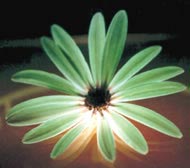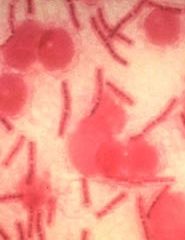
Ancient embalming not to be sniffed at.
Archaeologists thought they had mummification wrapped up. But a new analysis of ancient Egyptian embalming suggests that they have underestimated this sophisticated funerary practice.
Pharaonic undertakers used a wealth of oils, waxes and fats, say Stephen Buckley and Richard Evershed at the University of Bristol, UK. They are the first to study several mummies from different periods using modern analytical chemistry 1

Bugs behind typhoid and food poisoning give up genetic secrets.
Two teams have sequenced the genomes of two Salmonella bacteria. One is responsible for typhoid; the other causes food poisoning.
The genomes should lead to new ways to diagnose, treat and vaccinate against both diseases. Comparing the sequences should also clarify why the closely related bugs behave quite differently.
The two strains are called Typhi and Typhimurium. Typhi, the typhoid bug, infects onl

Recent events have confirmed that bioterrorism is no longer a threat but a reality. To provide wide-ranging access to the latest scientific information about anthrax and other potential bioweapons, Nature has put together a special online focus on this issue. This focus includes the pre-publication* of two research papers on anthrax toxin, as well as a collection of research, news and feature articles from our electronic archive. Because of the heightened interest in this area, among both the scient

Genetic engineering gives us the fluorescent daisy.
It’s produced in Italy and guaranteed to make the face of that special someone light up. It’s the luminous bouquet. Under ultraviolet light the apparently normal blooms glow an unearthly green.
“The fluorescent flowers show that genetic engineering can be developed just for beauty,” says their developer, Tito Schiva of the Experimental Institute of Floriculture, San Remo. The technique should work for any white flower, Sch

Researchers find two new leads for anti-anthrax drugs.
As fears over bioterrorism attacks spiral, researchers are making progress towards better anthrax drugs – but these are unlikely to reach the drugstore soon.
Of ten confirmed anthrax cases in the United States by Monday, four have been of the severe, inhaled form against which antibiotics often fail. By the time drugs destroy the bacteria responsible, Bacillus anthracis, the organisms have released enough lethal toxin t

The gold-loving king’s rich diet may have hastened his decay.
Legend says that lust for gold was the cause of King Midas’ downfall. But his appetite for meat may have destroyed the final monument to his greatness 1 .
A mound excavated 44 years ago in Turkey is thought to be the resting place of the eighth-century BC ruler of Phrygia. The large tomb, although built of durable cedar wood, is in surprisingly bad shape, says geophysicist Timothy Filley of the Car

Teleoperated robots for gathering moon dust are a step closer, according to new research by scientists at the University of Bristol. The team were able to complete a sample collection…

Astronomers have used the NASA/ESA James Webb Space Telescope (JWST) to observe the ‘inside-out’ growth of a galaxy in the early universe, only 700 million years after the Big Bang….

Experimental findings about plasma wave reflection could answer questions about high temperatures. There is a profound mystery in our sun. While the sun’s surface temperature measures around 10,000 degrees Fahrenheit,…

New types of sensors could help to develop plant protection products that are safe for bees. The increasing global demand for plant-based foods makes the use of pesticides necessary in…

Plants have a sophisticated mechanism for monitoring the production of new proteins. The “U1 snRNP” complex ensures that the protein blueprints are fully completed. This is important because cells tend…

Tiny transmitters provide first insights into precise migration routes of bats. Some bat species are among the world champions of seasonal migration in the animal kingdom. Leisler’s bat, for example,…

Researchers from Univ. of British Columbia and Drexel University Use Kirigami to Create Tunable Radio Antennas from MXene Nanomaterials. The future of wireless technology — from charging devices to boosting…

Using mechanisms inspired by nature to create new technological innovations is a signature of one Virginia Tech research team. The group led by Associate Professor Michael Bartlett has created an octopus-inspired adhesive,…

Materials researchers have created a new composite material that combines two incompatible properties: stiff yet with a high damping capacity. In brief Oscillations and vibrations damage machines and buildings, while…

Researchers will unveil the app on Oct. 15, at the ACM Symposium on User Interface Software and Technology. Northwestern University engineers have developed a new system for full-body motion capture…

UDDC Ensures Seamless Transmission of Image Data to Microdisplays. Researchers at the Fraunhofer Institute for Photonic Microsystems IPMS have developed a Universal Display Data Converter (UDDC). This enables the transfer…

Machine learning-equipped camera systems can be an effective and low-cost flood defence tool, researchers show. Smart CCTV systems trained to spot blockages in urban waterways could become an important future…